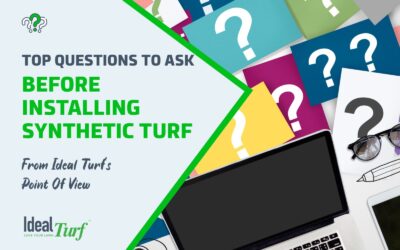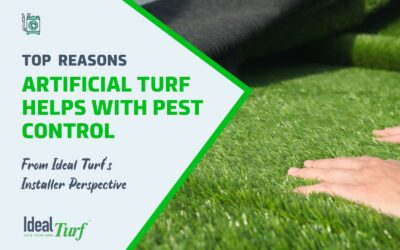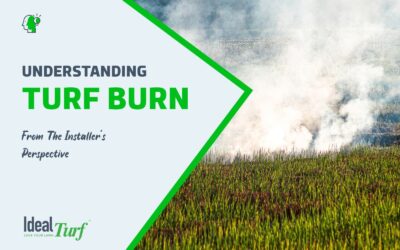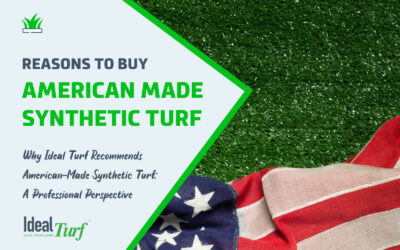Artificial Turf Lifespan & Durability: How Long Does Fake Grass Last?

For homeowners and businesses, artificial turf has always been the perfect solution to maintaining a pristine outdoor space with minimal maintenance.
However, one common concern among potential buyers is the lifespan and durability of artificial turf.
- How long will it last?
- What factors affect its longevity?
These questions are crucial in making an informed decision about investing in synthetic grass and offer insight into what kind of maintenance you’re in for.
Artificial turf is designed to be durable and long-lasting but can naturally degrade over time due to various factors.
However, you have plenty of influence on how well your turf ages.
Signs of wear and tear such as fading color, matting fibers, and uneven surfaces often indicate that the turf is approaching the end of its lifespan.
We’ve created this comprehensive guide to address these concerns and ensure you get the most out of your investment.
Understanding key factors influencing artificial turf lifespan is essential.

Artificial Turf Lifespan
The average lifespan of artificial turf varies, but it typically ranges from 10 to 15 years, depending on various factors. These factors include the quality of the turf, the level of usage, and the maintenance practices employed.
High-quality artificial turf that is installed correctly and maintained regularly can even exceed this range, providing a beautiful and functional surface for many years. Understanding the expected lifespan of your artificial turf and recognizing the signs of wear can help you plan for eventual replacement and ensure you get the most out of your investment.
Signs of Turf Degradation
Recognizing the signs of artificial turf degradation is crucial to maintaining a pristine and safe playing or recreational surface. Some common indicators that your artificial turf is nearing the end of its lifespan include:
- Fading Color: One of the most noticeable signs of turf degradation is the fading of its original vibrant color. Prolonged exposure to sunlight and harsh weather conditions can cause the fibers to lose their rich green hue, making the turf look dull and lifeless.
- Matting Fibers: Over time, the individual fibers of the turf can become matted and flattened due to heavy foot traffic and regular use. This matting can reduce the turf’s cushioning effect and make it less comfortable to walk or play on.
- Uneven Surfaces: As the turf ages, you may start to notice uneven surfaces or areas where the turf is no longer level. This can be caused by the breakdown of the underlying infill material or the settling of the ground beneath the turf, leading to dips, bumps, and other irregularities.
Identifying these signs early on can help you address minor issues before they become major problems, extending the life of your artificial turf and maintaining its aesthetic and functional appeal.

Factors Affecting Artificial Turf Lifespan & Durability
Material Quality
The quality of materials used in artificial turf significantly impacts its lifespan and performance. A typical artificial turf system consists of fibers, backing, and infill, each contributing to its overall durability.
Turf Fibers
Artificial turf fibers are typically made from polypropylene, polyethylene, or nylon. Polypropylene is the least expensive option but lacks durability compared to polyethylene, which strikes a balance between softness and toughness. Nylon, though the most durable, is also the priciest. Choosing the right fiber type depends on the intended use and budget considerations.
Backing Materials
The backing of artificial turf provides stability and support for the fibers. Primary backing materials are usually made from polypropylene or polyethylene, with polypropylene being less durable than polyethylene. Secondary backings, often made from latex, reinforce the primary backing and enhance overall durability.
Infill Materials
Infill materials like silica sand or crumb rubber are essential for maintaining the structure and resilience of artificial turf. The type and quality of infill used affect shock absorption, drainage, and turf stability.
Installation Process
Proper installation is crucial for maximizing the lifespan of artificial turf. A meticulous installation process involves clearing the area, preparing a suitable base, laying the turf correctly, and evenly distributing the infill. Common installation mistakes such as inadequate base preparation or incorrect seam sealing can lead to premature turf degradation.
Maintenance Practices
While artificial turf requires less maintenance than natural grass, regular care is necessary to preserve its appearance and functionality over time. Proper turf maintenance will keep your turf performing its best for years to come.
Regular Cleaning
Removing debris, dirt, and stains prevents fiber degradation and maintains the turf’s aesthetic appeal.
Brushing & Grooming
Regularly brushing the turf fibers helps keep them upright and prevents matting. Proper grooming also ensures even distribution of infill, which is crucial for turf stability.
Infill Replacement
Periodically replacing infill prevents compaction and maintains turf cushioning and drainage efficiency. This is important for a durable and long-lasting turf installation.
Turf Application & Usage Frequency
Artificial turf is tailored to meet the demands of various commercial and residential applications, each affecting its lifespan differently. Here’s a brief overview of the different types of artificial turf and their specific uses:
- Landscape Turf: Ideal for residential and commercial lawns, gardens, and public spaces. It provides a lush, green appearance with a soft feel, suitable for aesthetic purposes and light recreational use.
- Pet Turf: Engineered for pet areas, pet turf features durable fibers and a fully permeable backing for easy drainage. It’s treated with antimicrobial agents to reduce odors and bacteria, ensuring a clean play area for pets.
- Play Turf: Designed for playgrounds and high-traffic play areas, this turf offers a soft, cushioned surface to reduce injury risk from falls. It’s highly durable and perfect for high-traffic areas where children play.
- Sports Turf: Tailored for athletic fields, it provides excellent traction, shock absorption, and durability. Suitable for sports like soccer, football, and lacrosse, it includes robust padding and infill systems to withstand intense activity.
- Golf Turf: Mimics natural grass on golf courses, designed for putting greens, tee boxes, and fairways. It ensures a consistent surface and true ball roll, enhancing playability.
The frequency and intensity of use directly affect the lifespan of artificial turf. Heavy foot traffic and intense activities cause faster wear and tear. Regular maintenance and timely repairs can help extend the turf’s life and maintain optimal performance no matter how you use your artificial grass.
Environmental Factors
Environmental conditions such as weather patterns and UV radiation significantly impact artificial turf durability. Here’s how to mitigate some of these uncontrollable factors that impact your turf.
Weather Conditions
- Heavy Rainfall: Excessive rain can lead to water pooling and poor drainage, weakening the turf’s base. Proper drainage systems prevent waterlogging and maintain stability.
- Prolonged Drought: Drought can cause the ground beneath the turf to dry out and contract, leading to an uneven surface. Using drought-resistant turf and occasional watering helps maintain underlying soil moisture.
- Temperature Fluctuations: Extreme temperatures can cause the turf to expand and contract, leading to seam separation and an uneven appearance. Selecting temperature-resistant turf and proper installation techniques minimize these risks.
UV Radiation
- Fading Color: UV rays can cause the turf’s color to fade, making it look dull. High-quality turf incorporates UV-resistant additives to maintain its color.
- Fiber Degradation: Prolonged UV exposure weakens turf fibers, making them brittle and prone to breaking. UV-resistant materials protect the fibers, extending the turf’s lifespan.
- Protective Measures: Installing turf in shaded areas, using shade structures, and applying UV-protective coatings can enhance resistance to sun damage.

Factors That Extend Artificial Turf’s Lifespan
Regular maintenance, quality materials, and proper installation can significantly extend the lifespan of artificial turf. Here are the key factors that contribute to its longevity:
Innovations in Artificial Turf Technology
The artificial turf industry has seen significant advancements in materials and manufacturing technologies in recent years. These innovations have greatly improved artificial turf’s quality and durability.
Use Advanced Materials
Modern turf products use advanced polymers that are more resilient to wear and tear. These materials are designed to withstand heavy foot traffic, extreme weather conditions, and prolonged UV exposure without degrading.
Enhanced Manufacturing Techniques
Cutting-edge manufacturing processes ensure that the turf fibers are stronger and more consistent in texture and color. These techniques also improve the turf’s drainage capabilities, reducing the risk of water damage and mold growth.
Infill Improvements
New infill materials continue to be developed, such as organic materials, antimicrobial protection, cooling technology, etc., to enhance the turf’s performance and comfort. These infills help maintain the turf’s structural integrity and provide better cushioning and natural texture.
Maintenance Best Practices
Maintaining artificial turf in excellent condition requires regular care and attention. Here are some best practices to ensure your turf lasts as long as possible:
Regular Cleaning
Removing debris, leaves, and other contaminants from the turf surface prevents them from settling into the fibers and infill. Regular cleaning keeps the turf looking fresh and reduces the risk of bacterial growth.
Brushing
Periodically brushing the turf helps maintain the upright position of the fibers, ensuring that the surface remains soft and resilient. Brushing also helps distribute the infill evenly, crucial for maintaining the turf’s cushioning properties.
Infill Replacement
Over time, the infill material can become compacted or displaced. Regularly checking and replenishing the infill ensures turf maintains its structural integrity and performance. Proper infill levels also improve drainage and reduce the risk of surface damage.
Periodic Inspections
Conducting routine inspections allows you to identify and address minor issues before they escalate into significant problems. Look for signs of wear, seam separation, or damage to the backing, and take prompt action to repair any issues.
Professional Maintenance
Hiring professionals for maintenance tasks can ensure that your artificial turf is cared for properly. Professionals have the expertise and tools to perform thorough cleanings, infill replacements, and repairs, potentially extending the turf’s lifespan.
Combining these best practices with the latest advancements in turf technology, you can enjoy a beautiful, durable, and long-lasting artificial turf surface for many years.

Final Thoughts on Artificial Turf Lifespan & Durability
Artificial turf provides a low-maintenance alternative to natural grass, but its longevity depends on several critical factors.
By selecting quality materials, following proper installation procedures, and maintaining the turf regularly, you can ensure it remains vibrant and functional for years to come.
Whether you’re considering artificial turf for your home, business, or recreational facility, understanding these factors will help you make an informed decision.
Ready to transform your outdoor space with artificial turf?
Contact us today for a FREE design and installation estimate.
Click the “GET YOUR FREE QUOTE” button or call us at (806) 556-6012 to speak with our team and start your journey towards a beautiful, hassle-free lawn!

FAQs
How long does artificial turf typically last?
The lifespan of artificial turf generally ranges from 10 to 15 years, depending on factors such as quality, usage, and maintenance. High-quality turf that is well-maintained can even exceed this range.
What are the signs that my artificial turf needs replacement?
Common signs include fading color, matting fibers, and uneven surfaces. These indicators suggest that the turf is nearing the end of its lifespan and may need replacement to maintain its appearance and functionality.
Can extreme weather conditions damage artificial turf?
Yes. Extreme weather conditions such as heavy rainfall, prolonged drought, and temperature fluctuations can impact the turf’s base and structure. Proper drainage systems and selecting weather-resistant turf can help mitigate these risks.
How does UV radiation affect artificial turf?
UV radiation can cause turf fibers to fade and degrade over time. High-quality turf products incorporate UV-resistant materials to prolong their lifespan and maintain their appearance.
What are the best practices for maintaining artificial turf?
Regular cleaning, brushing, and infill replacement are essential. Periodic inspections help identify and address issues early. Hiring professionals for maintenance ensures the turf is properly cared for, potentially extending its lifespan.
Recent Posts
- Top Questions to Ask Before Installing Synthetic Turf – From Ideal Turf’s Point of View
- Top Reasons Artificial Turf Helps with Pest Control – From Ideal Turf’s Installer Perspective
- Understanding Turf Burn – From the Installer’s Perspective
- Reasons to Buy American Made Synthetic Turf
- Artificial Turf Lifespan & Durability: How Long Does Fake Grass Last?






